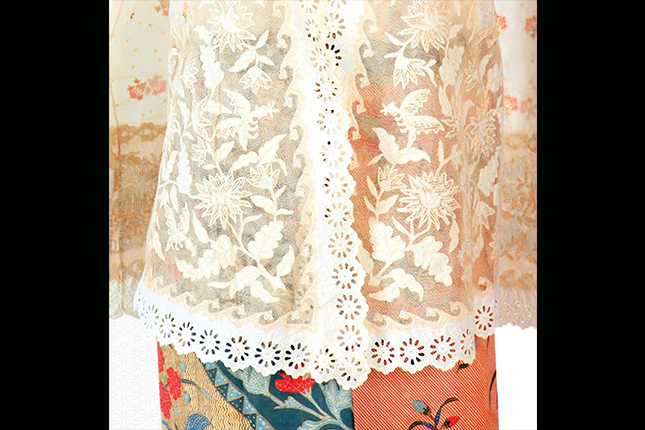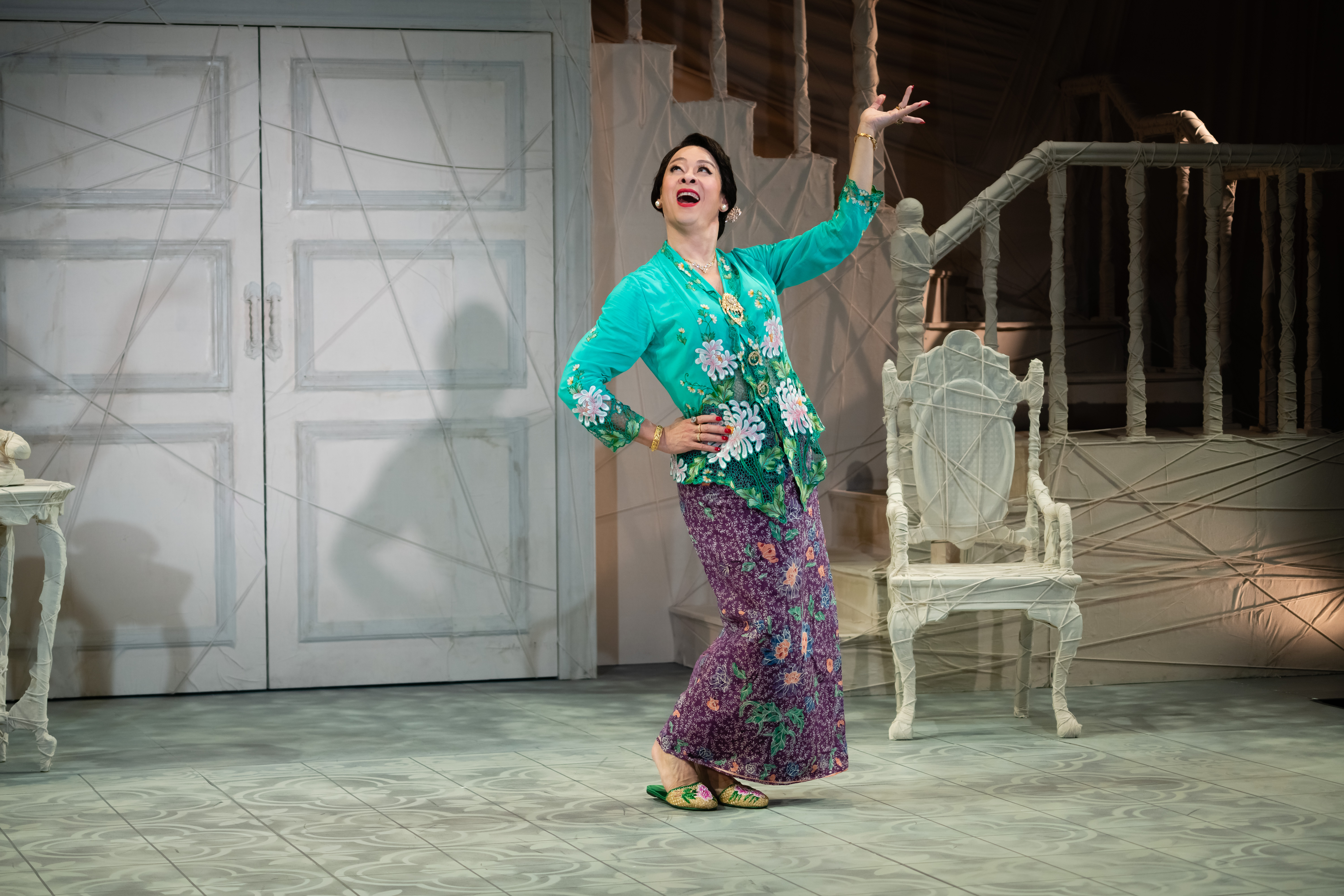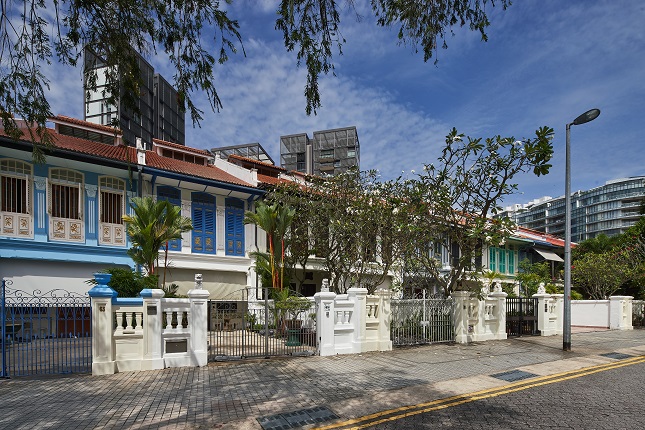Text by Jackie Yoong
Be Muse Volume 5 Issue 3 – Jul to Sep 2012
Stella Kon wrote Emily of Emerald Hill, drawing upon her Peranakan family background and experiences growing up in Singapore in the mid-20th century. The play won the Singapore National Playwriting Competition in 1983. It is a monologue about the life of Nyonya Emily Gan, who became the matriarch of a wealthy household through determination and sheer strength of character. In its rich characterisation of Peranakan life, the play expresses a distinctly Singaporean identity.

A critical and popular success both locally and overseas, Emily is the nation’s most-staged play. Critics embrace it for pioneering a convincing voice in Singaporean theatre, evoking strong local themes, familiar characters and recognisable patterns of speech. Above all, the play resonates with theatregoers worldwide through the universal values of love and humanity.
The exhibition Emily of Emerald Hill: Singaporean Identity on Stage explored the origins and Peranakan roots of the play, and examined its performance history and legacy in the context of Singapore’s Peranakan-language and English-language theatre scenes. On display were approximately 300 objects from over 30 individual and institutional lenders and donors, including Stella Kon, the three major Emily performers (Margaret Chan, Pearlly Chua, and Ivan Heng), and leading local theatre companies such as W!LD RICE and Theatreworks.

A first in national museum history, the Peranakan Museum built an exhibition around a Singaporean play and the story of local theatre. The museum is a space traditionally associated with the appreciation of material art forms. But this celebration of an intangible national treasure from the performing arts highlighted the fact that, as surely as art and objects, Emily of Emerald Hill is a cherished part of Singapore’s heritage.
STELLA KON: LIFE AND WORKS
In a cosy yellow corner of the exhibition designed to evoke a writer’s study, visitors can get up close and personal with Stella Kon. The playwright discusses candidly her life and works in a recorded interview made exclusively for the exhibition. Her reflections are enhanced with displays of photos, glassware once owned by important family members and copies of her key published works.
Born Lim Sing Po (literally “star waves”), Stella Kon is a descendent of prominent Peranakan philanthropists, including Dr Lim Boon Keng (1869 - 1957), Tan Boo Liat (1875 - 1934) and Tan Tock Seng (1798 - 1850). Dr Lim Boon Keng and Tan Boo Liat co-founded the Singapore Chinese Girls’ School; Tan Tock Seng contributed money to build the hospital named after him, and to build the Thian Hock Keng temple, the oldest Chinese temple in Singapore. In the play, Tan Boo Liat is reflected in the character of Emily’s father-in-law.
Stella Kon is one of Singapore’s earliest and most prolific female writers. Her works are concerned with distinctly Singaporean themes, and reflect her national and multicultural heritage. Besides plays, she has written short stories, novels, poetry, and since 2000, primarily musicals.
SETTING THE STAGE
Stella Kon derived the setting of the play from her childhood experiences in the 1950s, growing up in a house called Oberon located at 117 Emerald Hill. In a part of the exhibition, Kon worked with museum curators to create a space that evokes the interior of Oberon. Mixing fact and fiction, the display re-imagines the setting of the play through a combination of original furnishings from the house and objects from the Perankan Museum. A sarong kebaya worn by the playwright’s grandmother (Mrs Seow Poh Leng, née Polly Tan Poh Li, 1898 - 1969) – inspiration for the character Emily Gan – greets visitors to this part of the exhibition.

This photograph shows Stella Kon's grandparents and their children - the inspiration for parts of the play.
Three large objects from Oberon, anchored in the memories of the family, dominate the space: an elegant cupboard packed with family porcelain and silver; a standing clock that was a gift to Oberon’s matriarch (Stella’s grandmother); and a grand, silver horseracing trophy that belonged to an honourable ancestor (Stella’s great-grandfather). Close attention was also paid to key architectural details that evoke the look of Oberon: two large pillars were constructed and wall-coverings that mimic the exact floral wall tiles in Oberon were produced. Mother-of-pearl chairs, which were not part of the furnishings at Oberon, are also included in this imagined world of Emily. Embodying the spirit of the play, this installation blends reality and fantasy to set the stage.

Made in the region, the cupboard adorned the sitting room of Oberon, Stella Kon's family home on Emerald Hill.
PERFORMING EMILY: THE MANY FACES OF EMILY GAN
The remarkable performance history of this landmark play includes over 300 performances over 30 years to 2012, across four continents, seven countries, and seventeen cities. Many acclaimed actors and directors have staged Emily through the years; some of the best-known actresses and actors are Margaret Chan, Pearlly Chua, Ivan Heng, Leow Puay Tin, Neo Swee Lin, Claire Wong, Aileen Lau and Jalyn Han.

The exhibition focused on the first three. Margaret Chan is often considered the “original Little Nyonya”, since she was the first Singaporean to portray Emily, and was given a coveted invitation to perform the play at the prestigious Traverse Theatre in Scotland in 1986.

Malaysian Pearlly Chua has made a career as Emily, and has performed the character over 160 times since 1990.

Ivan Heng is the only man to play the role; the high regard he has for the play is reflected in his decision to launch his company W!LD RICE with a staging of the play.

Original posters, photos, brochures, props and costumes of these three Emilys were on display at the exhibition within a space designed as a black-and-white dressing room. In this backdrop of dramatic intimacy, they shared reflections of their Emily journeys via interviews recorded on video especially for the exhibition. A soundtrack of songs performed by the various actors in the play through the years played softly in the background, providing audio to enliven the experience.
STAGING A NATION: ENGLISH LANGUAGE THEATRE IN SINGAPORE
Emily is regarded as a seminal work and a landmark event in the history of English language theatre in Singapore. A long wall of brochures and posters from key local productions in the post-war period through the 1980s provides context for the play. Local theatre was born in the 1960s and 1970s, but remained limited, largely due to a lack of trained full-time professionals, minimal funding, and no critical mass of audience comfortable with English. The 1980s marked a golden decade as these conditions improved, resulting in professionalisation of the scene and creation of influential local productions, including Emily.
STAGING A COMMUNITY: PERANAKAN LANGUAGE THEATRE IN SINGAPORE
Themes of family and nostalgia, and the technique of female impersonation (via Ivan Heng’s performance) in Emily parallel issues in Peranakan language theatre, called Wayang Peranakan, in Singapore. It was performed in Baba Malay, a Malay creole with heavy borrowings from the Hokkien Chinese dialect. Wayang Peranakan emerged in the early 1900s and experienced a boom in the post-war 1950s. Casts consisted only of men (as it was considered socially inappropriate for women to perform onstage) until the 1960s, and the plays were usually staged for charities. After a lull in the 1960s and 1970s, the scene became vibrant again in the 1980s amidst a background of heightened interest in Peranakan culture and community in Singapore. Since the success of Pileh Minatu (Choosing a Daughter-in-law) in 1984, Wayang Peranakan has been staged almost every year by Gunong Sayang, one of the oldest Peranakan associations in Southeast Asia.
A PERANAKAN TALE
At the heart of Emily is a Peranakan tale, inspired by the author’s Peranakan background. The play makes several material references to Peranakan art of the late 19th and early 20th centuries. These objects reflect the varied roles of the character Emily Gan as woman, wife, mother, daughter-in-law, hostess and socialite. Drawing from the museum’s collection, key objects were displayed accompanied by significant passages from the play. The objects were displayed in showcases spread out across a large book-like structure, representing visually the simultaneous identities of Emily as a script, a play and an exhibition. An Emily mannequin, dressed in a traditional bridal costume set on a mini-stage, planted the character within the setting. A strikingly unconventional bright pink provided the background, highlighting the contemporary aspects of the play. Pink was a favoured colour for Peranakan art at the turn of the 20th century.
FROM PAGE TO STAGE
A theatrette was specially created for this exhibition to facilitate appreciation of Emily as a performing art. Only six out of the approximately 350 performances of the play are known to have been recorded. Highlights from these six performances were stitched together to create a 12-minute video that looped daily to provide visitors with a taste of the play. The full play could also be enjoyed daily at 3pm. This version comprised videos of five Emilys (Margaret Chan, Ivan Heng, Neo Swee Lin, Pearlly Chua and Leow Puay Tin). Each actor has created his or her own interpretation of Emily and, in fact, the same actor portrays her differently with each new production. This underlines the temporal, personal, and fluid nature of theatre as art. An additional treat in this part of the exhibition was the chance to sit in original theatre chairs kindly donated by the Capitol Theatre in Singapore. On 7 July 2012, a live performance of Emily by Margaret Chan was held at the exhibition.
THE EMILY LEGACY
Emily has inspired artistic creativity both locally and abroad. Some of the products inspired, including paintings, poetry, literature and plays, are displayed in the exhibition. A generation of local young people has studied and performed Emily in schools. As a role model for national theatre, the play has left an indelible mark on some of Singapore’s leading theatre practitioners.

As a pillar of local literature, Emily of Emerald Hill has been frequently referenced in academic works and thousands of youths have studied and dramatized it in school. While distinctly Singaporean, Emily has been interpreted as a symbol of Peranakan, Malaysian, Southeast Asian, and Asian identities. Above all, the play deals with the universal values of love and humanity.
Translations into multiple languages, including Mandarin, Icelandic and Japanese, affirm its international appeal. More than just a play, Emily of Emerald Hill is embedded in the Singaporean consciousness and its cultural memory.
Jackie Yoong is Curator, Peranakan Museum.
















